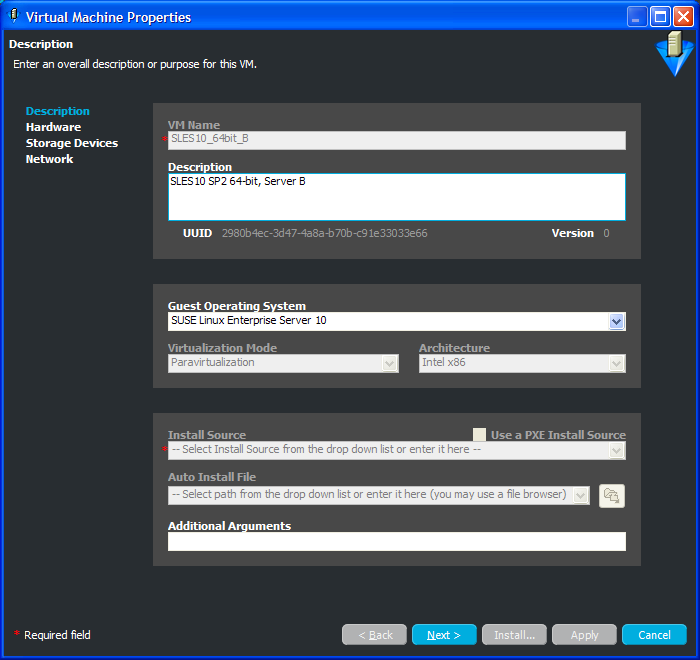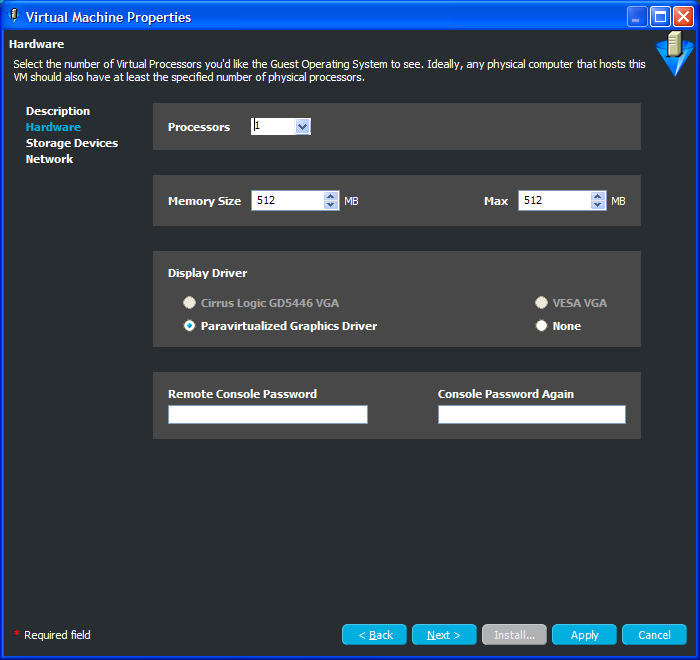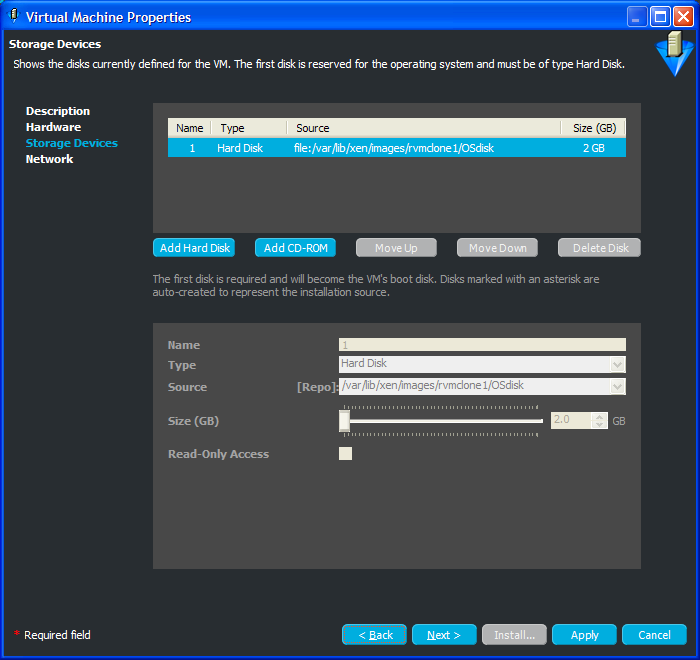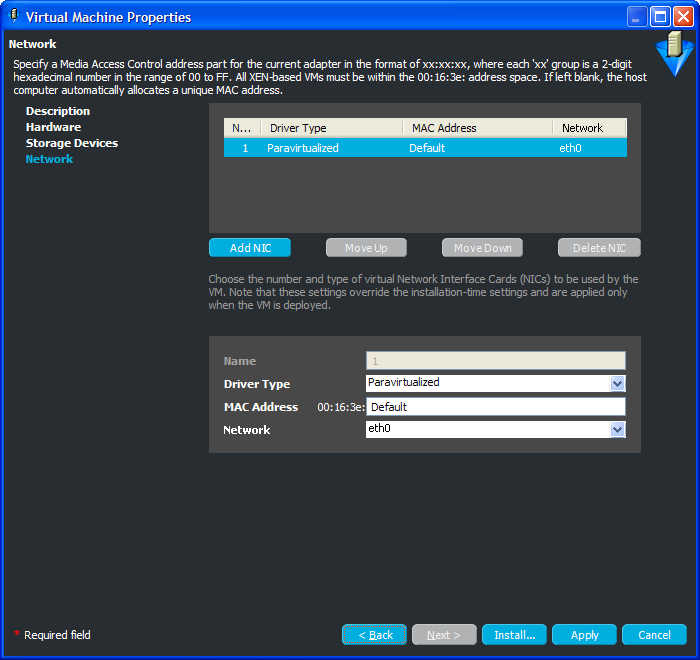5.8 Editing VMs
VMs can be edited at any time. However, the fields and sections that are displayed on each of the four wizard pages depend on various circumstances:
-
Which type of VM is it? Xen, VMware, or Hyper-V?
-
What is the VM’s installed state? Defining, defined, installing, or installed?
-
What is the VM’s defined state? Defining or defined?
-
What is the run time state of the VM? Running, paused, suspended, or stopped?
-
Is the VM state unknown?
Any combination of these factors determines which fields can be edited or shown. The displayed fields that can’t be edited are inaccessible (dimmed), or if no fields on a wizard page are editable, the page isn’t shown.
IMPORTANT:If the VM that you want to edit is running, only a few of its properties can be changed. If you want to edit a running VM, know that any changes are only retained in RAM, so when this instance if the VM is stopped, those edits are not kept.
The following steps include information for all possible VM fields and pages. The VM you are editing might not have all of the fields and pages.
To edit a VM, run the Virtual Machine Properties Wizard:
-
If you want to retain your edits on a VM, click the view in the VM Client, right-click the VM that you want to edit, then select .
-
Do one of the following to start the wizard:
-
Select a VM, then click the
 button.
button.
-
Select a VM, then click > .
-
Select a VM, then press Ctrl+E.
-
Right-click any listed VM, then select .
The following wizard page is displayed:

The above example is for a stopped VM.
-
-
Fill in the available fields:
Description: Note the purpose and any other specifics you might require of the VM. These notes apply to all versions of this VM.
Guest Operating System: The operating system you want to install on your VM.
If the column on the view displays Unknown for the VM you are editing, you can select an operating system here.
Additional Arguments: This field applies only to paravirtual installations. These are Linux install arguments, which are operating system parameters similar to the information entered in a GRUB boot loader when running on bare hardware in SLES and SLED. Additional network installation information can be added here, which is used during the build process to find the installation source for the VM build process.
-
Click to display the following wizard page:

The above example is for a stopped VM.
-
Fill in the available fields to define the kind of hardware to be virtualized for the VM:
Processors: The number of virtual processors the VM has.
Memory Size: The amount of virtual RAM the VM has, or paravirtualized memory that can be used by the VM if it is paravirtualized.
Max: The amount of virtual RAM the VM has, or paravirtualized memory that can be used by the VM if it is paravirtualized.
Display Driver: The properties of the VM’s display. If you have chosen paravirtualization for this VM, your only option is . If you have chosen full virtualization, you can select between or the on-board VGA. If you do not need a display, you can turn off the display on a fully virtualized machine.
Remote Console Password: The password for remotely controlling the VM. Use the two fields to confirm that the password is typed correctly.
-
Click to display the following wizard page:

The above example is for a stopped VM. The default for the field is . The other possible types are iSCSI, NPIV, and NAS. For more information, see Step 5.
The Storage Devices page is for defining the hard drives and CD or DVD drives that you want to include in the VM profile. The first device must always be a hard disk that cannot be removed unless another hard disk has been put into the first slot. This is the only disk (Disk 0) that is stored. All other disks are virtual and are created upon launching the VM. You can add any other storage devices you want to the VM and prioritize their use in the list.
IMPORTANT:After installing a VM, you cannot change the disk settings for existing disks. However, you can add and configure newer disks.
-
To fill in the storage device information, select a task from the following table:
Tasks
Steps
Additional Details
Adding a hard disk to your VM
-
Click .
-
Fill in the following fields:
Name: The name is the number in the order the drive appears in its VM image list.
Type: Select the type of hard disk you want to create on the VM:
-
Hard Disk
-
iSCSI
Not supported as the first disk.
-
N_Port ID Virtualized Storage
Not supported as the first disk.
-
Network Attached Storage
Source: The repository on the hard disk of the VM.
Size (GB): The VM’s hard drive size, ranging from 0.25 GB (250 MB) to 4 TB. This is the maximum allowable size of the VM.
Read Only Access: Select this option to give the hard drive Read-Only access. By default, hard drives are writable.
Fabric ID: (Available only for the N_Port ID virtualized storage). Select or specify a fabric ID that uniquely identifies a SAN repository.
The drop-down list is populated with fabric IDs of the discovered SAN repositories.
World Wide Name: (Available only for the N_Port ID virtualized storage). Select or specify a unique World Wide Name.
The World Wide Name value is automatically assigned for the NPIV disks. You can edit it, if required.
Target ID: (Available only for the N_Port ID virtualized storage). Specify the target ID of the SAN repository.
LUN: (Available only for the N_Port ID virtualized storage). Specify a LUN value between 0 and 254.
-
-
Click .
The following restrictions apply per VM:
-
Limit of 4 fully virtualized disks (hda-hdd).
-
Limit of 16 paravirtualized disks (xvda-xvdp).
While adding an additional NPIV disk to a VM, ensure that the disk values for Fabric ID, World Wide Name, Target ID, and LUN are unique for each NPIV disk of the VM.
Creation of a block-based VM is not supported for NPIV.
IMPORTANT:iSCSI and NPIV can be used for secondary disks. However, if you add iSCSI or NPIV as a secondary disk, you can change the order of the disks and make it to be the first disk. This is not supported.
If you define iSCSI or NPIV as a first disk, when the VM is stopped and restarted, the configuration file that is stored on the iSCSI or NPIV disk is looked for in a local repository, and when not found, a local repository is created for the VM, thus losing connection to the iSCSI or NPIV disk.
Adding a CD-ROM or DVD ROM to your VM
-
Click .
-
Fill in the following fields:
Name: The name is the number in the order the drive appears in its VM image list.
Type: Select the type of CD-ROM you want to create on the VM:
-
CD-ROM
-
DVD
Source: The repository on the hard disk of the VM.
Size (GB): The size is zero and cannot be changed.
Read Only Access: These drives can only have Read-Only access.
-
-
Click .
IMPORTANT:If you add a CD-ROM or DVD-ROM, the VM can only be moved, migrated, or used to create a template if the CD-ROM’s or DVD-ROM’s ISO or image is accessible through shared storage.
Rearranging the order in which each storage device is accessed
-
Select the storage device whose order you want to change.
-
Click or .
The first storage device in the list must be a hard disk, which is the only one actually stored in the VM image.
Deleting a storage device
-
Select the storage device you want to delete.
-
Click .
Removes the selected storage device from the table.
WARNING:If the storage device is based on a disk image, the disk image is also deleted. To preserve the disk image, manually copy it to another location before deleting the storage device.
-
-
Click to display the following wizard page:

The above example is for a stopped VM.
The network devices are added, deleted, and defined on the Network page, where you add specific information about your network connections or intended network connections for your VM. You can define more detailed NIC settings in your auto-install files or when performing a guest installation.
-
To fill in the NIC information, select a task from the following table:
-
To complete and close the wizard, click .
You can click to make further changes before applying the edits.
The wizard configuration changes are applied and the VM is saved in the view.
Focus is returned to the view after you exit the wizard, with the edited VM selected in the list.
To install an edited VM at a later time, see Section 5.5, Installing a VM.